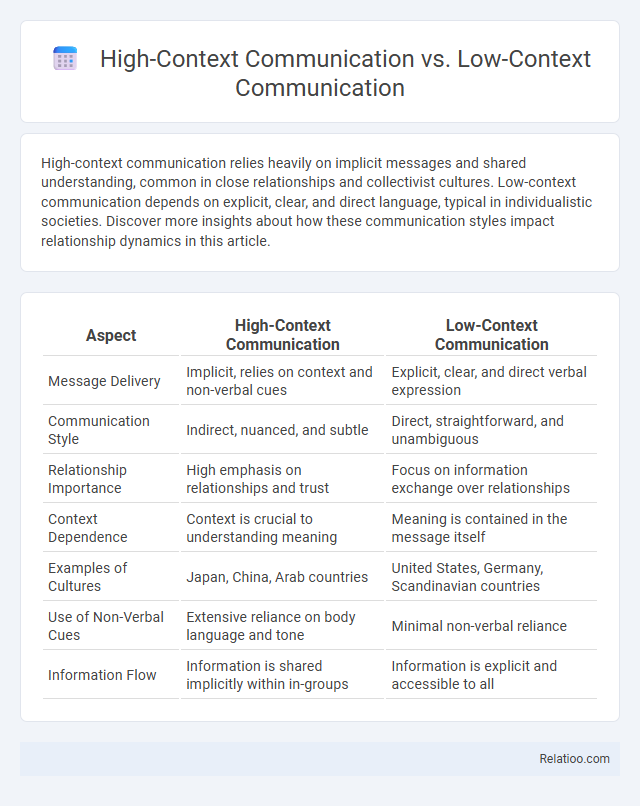High-context communication relies heavily on implicit messages and shared understanding, common in close relationships and collectivist cultures. Low-context communication depends on explicit, clear, and direct language, typical in individualistic societies. Discover more insights about how these communication styles impact relationship dynamics in this article.
Table of Comparison
| Aspect | High-Context Communication | Low-Context Communication |
|---|---|---|
| Message Delivery | Implicit, relies on context and non-verbal cues | Explicit, clear, and direct verbal expression |
| Communication Style | Indirect, nuanced, and subtle | Direct, straightforward, and unambiguous |
| Relationship Importance | High emphasis on relationships and trust | Focus on information exchange over relationships |
| Context Dependence | Context is crucial to understanding meaning | Meaning is contained in the message itself |
| Examples of Cultures | Japan, China, Arab countries | United States, Germany, Scandinavian countries |
| Use of Non-Verbal Cues | Extensive reliance on body language and tone | Minimal non-verbal reliance |
| Information Flow | Information is shared implicitly within in-groups | Information is explicit and accessible to all |
Understanding High-Context and Low-Context Communication
High-context communication relies heavily on implicit messages, shared experiences, and nonverbal cues, making it prevalent in cultures where people have close relationships and common backgrounds. Low-context communication depends on explicit, clear, and direct verbal information, typical in cultures prioritizing individualism and clarity to avoid ambiguity. Misunderstandings often arise when individuals from high-context and low-context cultures interact without recognizing these differing communication styles.
Key Characteristics of High-Context Communication
High-context communication relies heavily on implicit messages, nonverbal cues, and the surrounding context rather than explicit words, emphasizing shared experiences and relationships to convey meaning. Key characteristics include reliance on indirect language, deep cultural understanding, and the importance of trust and social harmony in interactions. Misunderstandings often arise when individuals from low-context cultures, which prioritize direct and clear communication, interpret high-context messages without sufficient background knowledge or awareness of subtle cues.
Defining Features of Low-Context Communication
Low-context communication is characterized by explicit, clear, and direct messages where meaning is primarily conveyed through words rather than situational context or nonverbal cues. This communication style relies heavily on detailed information, structured conversations, and precise language to ensure clarity and minimize misunderstandings. Your ability to navigate low-context communication effectively depends on focusing on explicit content and clear, unambiguous messaging.
Cultural Examples of High-Context and Low-Context Societies
High-context communication thrives in cultures like Japan and Arab countries, where implicit messages and nonverbal cues are essential, whereas low-context communication dominates in societies such as the United States and Germany, emphasizing explicit, direct language. Misunderstandings often arise when individuals from high-context cultures interpret low-context communication as blunt or insensitive, while those from low-context cultures may view high-context communication as ambiguous or evasive. Recognizing these cultural communication styles is crucial for effective intercultural interaction and minimizing cross-cultural misinterpretations.
Impact on Interpersonal Relationships
High-context communication relies heavily on implicit messages and shared understanding, fostering deeper emotional connections in interpersonal relationships but risking misunderstanding when backgrounds differ. Low-context communication emphasizes explicit, clear, and direct messages, promoting transparency but sometimes causing perceived coldness or bluntness. Misunderstandings arise when individuals from these different communication styles interact, potentially leading to conflict or weakened trust due to varying expectations in message interpretation.
Business Implications of Communication Styles
High-context communication relies heavily on implicit messages, non-verbal cues, and shared experiences, making it essential in business cultures that prioritize relationship-building and trust, such as Japan or the Middle East. Low-context communication emphasizes explicit, direct language and clear information transfer, common in Western countries like the United States and Germany, ensuring efficiency and clarity in contracts and negotiations. Understanding these differences can prevent costly misunderstandings in your global business interactions, improving collaboration and reducing friction across diverse cultural contexts.
Challenges in Cross-Cultural Communication
High-context communication relies heavily on implicit messages, nonverbal cues, and shared cultural understanding, while low-context communication emphasizes explicit, clear, and direct language, creating challenges for cross-cultural interactions. You may experience misunderstandings when interacting with individuals from different cultural backgrounds because high-context communicators expect you to read between the lines, whereas low-context communicators expect precise verbal articulation. These differences can lead to misinterpretation, reduced trust, and ineffective collaboration without awareness and adaptation to diverse communication styles.
Strategies for Bridging High and Low-Context Differences
High-context communication relies on implicit messages and shared cultural cues, while low-context communication emphasizes explicit, clear, and direct language. To bridge these differences, you should prioritize active listening, clarify assumptions, and adapt your communication style by providing context when necessary, ensuring mutual understanding. Implementing feedback loops and encouraging open dialogue helps minimize misunderstandings across diverse cultural communication styles.
Case Studies: Real-World Communication Breakdowns
High-context communication relies heavily on unspoken cues and shared understanding, as seen in Japanese business negotiations where subtle gestures carry significant meaning, leading to confusion for Western partners used to explicit low-context communication. Low-context communication emphasizes clear, direct messages typical in American corporate environments, often causing misunderstandings with cultures that expect implicit shared background knowledge. Your ability to navigate these differences can prevent real-world communication breakdowns, such as the failed collaboration between multinational teams where divergent communication styles undermined project goals.
Tips for Effective Multicultural Communication
High-context communication relies heavily on implicit messages and nonverbal cues, while low-context communication depends on explicit, direct language, making awareness of these differences crucial for preventing misunderstandings. To improve your multicultural communication, pay close attention to cultural norms, actively listen for underlying meanings, and clarify ambiguous messages promptly. Adapting your approach to match the context style of your audience enhances mutual understanding and fosters stronger relationships.

Infographic: High-Context Communication vs Low-Context Communication
 relatioo.com
relatioo.com